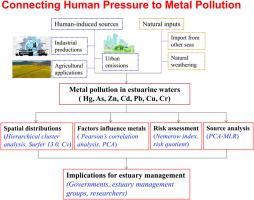Ecotoxicology and Environmental Safety ( IF 6.2 ) Pub Date : 2021-09-03 , DOI: 10.1016/j.ecoenv.2021.112747 Lixia Niu 1 , Huayang Cai 1 , Liangwen Jia 1 , Xiangxin Luo 1 , Wei Tao 2 , Yanhong Dong 2 , Qingshu Yang 1

|
Understanding the metal pollution can help governments and estuary management groups manage metal inputs. Here, we comprehensively analyzed the behaviors of seven metals Cd, Zn, Cu, As, Pb, Cr, and Hg in water and the responses of these metals to hydrological connectivity in the Pearl River Estuary. The analyses were based on the field measurements of August-2016 in the estuary and January-2016 in the upper river mouth. We also assessed the ecosystem health of these metals. Overall, this estuary had an overall moderate pollution level, with occasional severe perturbations. The mean concentration of individual metal was in the order of Zn > As > Cu > Cr > Pb > Cd > Hg. The eastern estuary was more heavily polluted by metals (notably, Zn, Cd, and Cu) than the western estuary; this condition was attributable to sewage and industrial effluent discharges from the eastern urban cities of Dongguan and Shenzhen. Longitudinally, high levels of Cd and Zn appeared in the upper estuary, while elevated levels of Cu, As, Pb, Cr, and Hg were found in the middle and lower estuaries. The riverine inputs and estuarine mixing significantly influenced the distribution and movement of trace metals in the estuary, and have contributed to phytoplankton productivity (chlorophyll-a > 10 μg/L). River inflow inhibited the vertical diffusion of metals, and tidal currents facilitated surface-to-bottom mixing. Cu and Cd posed ecological risks. We determined the source contributions and transport routes of the metals using principal component analysis combining with multiple linear regression. The results of this study suggest that the source apportionment of metals can help to manage the source input entering into the estuary. Further, identified hydrological connectivity of metals can inform water quality managers in the highly anthropogenically influenced estuary.
中文翻译:

珠江口金属污染及其对河口管理的影响:与河口混合相关的水文连通性的影响
了解金属污染可以帮助政府和河口管理团体管理金属输入。在此,我们综合分析了珠江口水中Cd、Zn、Cu、As、Pb、Cr、Hg 7种金属的行为及其对水文连通性的响应。分析基于 2016 年 8 月在河口和 2016 年 1 月在河口上游的现场测量。我们还评估了这些金属的生态系统健康状况。总体而言,该河口的总体污染水平为中等,偶尔会出现严重扰动。单个金属的平均浓度顺序为 Zn > As > Cu > Cr > Pb > Cd > Hg。东部河口比西部河口受金属(尤其是锌、镉和铜)污染更严重;造成这种情况的原因是东部城市东莞和深圳的污水和工业废水排放。纵向看,上河口Cd、Zn含量较高,中下游河口Cu、As、Pb、Cr、Hg含量较高。河流输入和河口混合显着影响了河口微量金属的分布和运动,并有助于浮游植物生产力(叶绿素-a > 10 微克/升)。河流流入抑制了金属的垂直扩散,而潮汐流则促进了表面到底部的混合。铜和镉造成生态风险。我们使用主成分分析结合多元线性回归确定金属的来源贡献和运输路线。这项研究的结果表明,金属的来源分配有助于管理进入河口的来源输入。此外,确定的金属水文连通性可以为受高度人为影响的河口的水质管理人员提供信息。











































 京公网安备 11010802027423号
京公网安备 11010802027423号